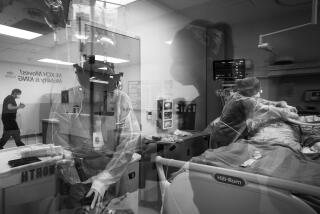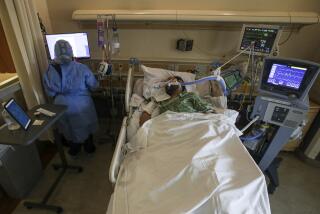What’s the risk of COVID-19 for a healthy young person?

Here’s a quick guide to how the novel coronavirus spreads, how likely you are to get it and what you can do to stay healthy.
The first person diagnosed with COVID-19 in New Jersey was a 32-year-old man who had been admitted to the hospital.
In a video posted to Twitter over the weekend, the patient explained that he’d had no underlying medical conditions that would make him susceptible to severe illness, yet the new coronavirus was making him sicker and sicker. He spoke from a hospital bed where he had been hooked up to tubes helping him breathe.
The video, which has been viewed more than 440,000 times, raised concerns that young people may be more vulnerable to COVID-19 than health experts had been letting on.
So is that really true?
According to medical experts, no. The risk of serious illness due to COVID-19 is far higher for people who are older and have underlying medical conditions. People 60 and older accounted for more than 80% of the deaths in China, according to a major study in the Journal of the American Medical Assn.
But rare exceptions have popped up in the scientific literature, said Dr. Anthony Fauci, director of the National Institute of Allergy and Infectious Diseases.
“There will be, as we’ve seen in influenza, an occasional person, who’s young and healthy, who winds up getting COVID-19, seriously ill and dies,” Fauci said in an interview with Dr. Howard Bauchner, the editor of JAMA. “But if you look at the weight of the data, the risk group is very, very clear.”
With the U.S. outbreak in its early stages, there isn’t yet good data on the ages and other characteristics of infected patients here. So experts have relied on the analysis of nearly 45,000 COVID-19 patients in China that was conducted by the country’s Center for Disease Control and Prevention.
The study accounts for more than a third of all reported cases of the disease. Worldwide, 118,000 people have been diagnosed with the disease so far and 4,200 have died from it.
The study identified very few deaths among people under 40. More than 12,000 people in that age group were infected, but only 26 died. It is unclear if those people had other medical conditions, such as asthma or cancer, that may have made them more vulnerable.
The study found that the chance of dying from COVID-19 clearly increases with age.
There were no reported deaths from COVID-19 in children under 10, and other studies have suggested that children who are infected do not become very sick.
These are the COVID-19 mortality rates by age calculated by the Chinese CDC:
- ages 10-19: 0.2%
- ages 20-29: 0.2%
- ages 30-39: 0.2%
- ages 40-49: 0.4%
- ages 50-59: 1.3%
- ages 60-69: 3.6%
- ages 70-79: 8%
- 80 and over: 14.8%
The overall mortality rate estimated by researchers was 2.3%, but experts caution that it is likely exaggerated due to milder cases that have gone uncounted.
As for the younger deaths, they represent what you would see if you pored over any disease data with a magnifying glass, experts say.
“It is possible, but apparently very rare that otherwise healthy people can get severe disease,” said Dr. Jeffrey Klausner, an infectious disease expert at UCLA’s Fielding School of Public Health. “But right now we have patients in the hospital with severe influenza that were otherwise healthy people in their 40s and 50s. ... It’s rare as well, but it occurs.”
Indeed, in the 2018-19 flu season, 2,450 people between the ages of 18 and 49 died in the United States, according to the CDC. The mortality rate from the flu is lower than from COVID-19, but far more people caught the flu last season — more than 35 million — than have gotten COVID-19 so far this year.
In an interview with a local CBS station in New York, the New Jersey COVID-19 patient identified himself as James Cai, who works as a physician assistant. Cai said he believes he contracted the virus at a conference in New York and within three days was hospitalized because it had spread to his lungs.
“The virus is everything. Diarrhea, watery eyes, shortness of breath, chest pain, you name it. High fever,” he told the CBS station. “Every day is getting worse ... it happened so quick.”
Cai isn’t the first person to raise concerns about how quickly people become severely ill. The average time it takes for people to start showing symptoms after infection is about five days, according to a new study by Johns Hopkins University, but there have been reports of rapid decline once illness sets in.
At a news conference Sunday, Timothy Killian, spokesman for nursing home Life Care Center in Kirkland, Wash., said it had been “surprising and shocking” to see patients become deathly ill so quickly. At least 19 people who were linked to the nursing home have died, most of them in their 70s and 80s.
“We have found this to be troubling and volatile and unpredictable,” Killian said. “We have seen as little as one hour, somebody getting no symptoms to going to symptoms that were severe enough that they needed to be transferred to the hospital, and then within a short amount of time, that patient died.”
Scientists are still learning more about how the virus kills its victims. But it’s possible the older patients did not show the telltale signs of the virus, including a fever, that could have clued people into the illness earlier, Klausner said.
Elderly people don’t mount a fever the same way that younger people do, because their immune systems begin to react differently to viruses as they age, he said. Nursing home staff should be on the lookout for not just fever but also cough, fatigue and headaches, he said.
“While they are brewing infection, it may go unnoticed,” Klausner said.
Times staff writers Richard Read and Rong-Gong Lin II contributed to this report.
More to Read
Sign up for Essential California
The most important California stories and recommendations in your inbox every morning.
You may occasionally receive promotional content from the Los Angeles Times.











